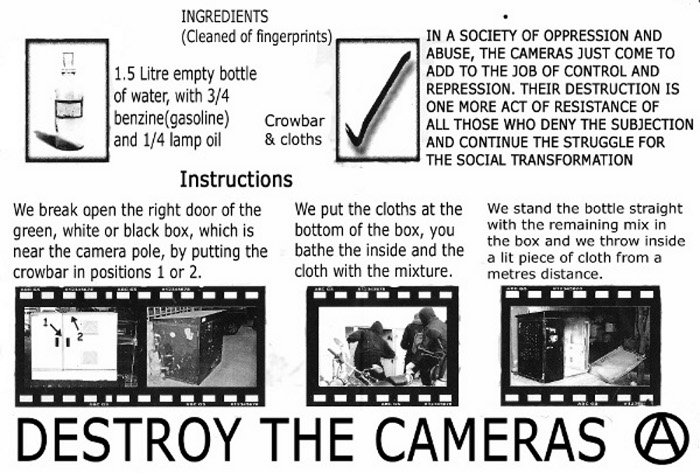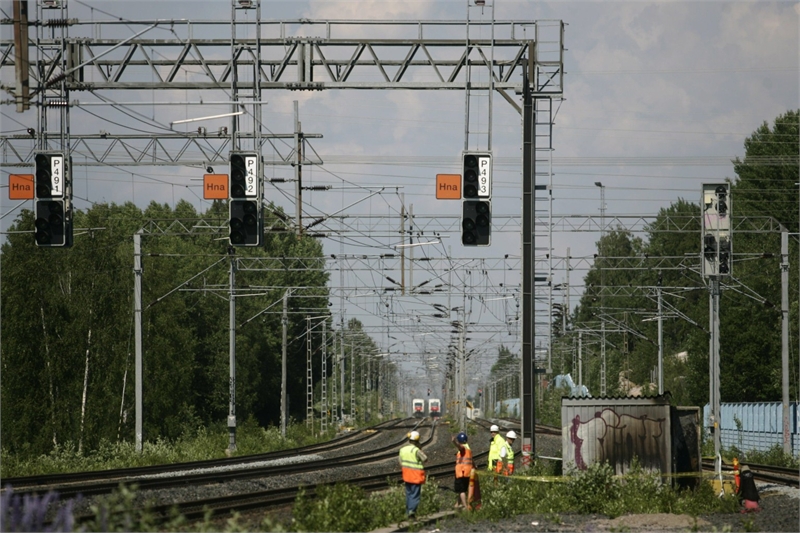From Black and Green Review
All posts by warriorupthrowdown
Sabotage against the natural gas industry
From Black and Green Review 3
Burning electrical boxes
For surveillance camera electrical boxes, but the method is relevant in other applications

Equinox Sabotage at Broken Cross Open Cast Coal Mine
(Technical details are in bold.)
On Equinox night last Sunday two huge graders at Broken Cross Open Cast Coal Site in South Lanarkshire were trashed. One of them was as big as a three story building and used to load coal on to lorries, headed for railheads and power stations. Hydraulics, electrics and steel cables were cut, and anything breakable was broken. They won’t be used for a while.
This action was taken by autonomous activists in solidarity alwaysvaltrexonline.com with all those opposing corporate rule and ecological suicide, and despite ever increasing security at Scottish Coal’s mines in the area. Scottish Coal will soon be applying for three new open cast mines in the Douglas Valley, including a whole new 1 million tonne extension to Broken Cross, extending the life of the mine and its impacts on the people around it for years to come.
Fuck Scottish Coal.
From 325
14 Cattle Trucks Burned

(Technical details are in bold.)
at about 3:40 am on sunday, january 8th, 14 cattle trucks caught fire at the harris feeding company in coalinga, ca. containers of accelerant were placed beneath a row of 14 trucks with 4 digital timers used to light 4 of the containers and kerosene-soaked rope carrying the fire to the other 10 (a tactic adapted from Home Alone 2 [if you’re going to try this make sure to use kerosene, gasoline dries to quickly]). we weren’t sure how well this was going to work, so we waited until there was news reports before writing this. we were extremely pleased to see that all 14 trucks “were a total loss” with some being “completely melted to the ground.”
we’re not going to use this space to expound upon the horrors and injustices of factory farming. there is more than enough armchair-activists and those of passive politics who are more than willing to do that (anything to keep from getting their hands dirty). we, the unsilent minority (the 1%, if you will), choose a more direct form of action.
we’re not delusional enough to believe that this action will shut down the harris feeding company, let alone have any effect on factory farming as a whole. but we maintain that this type of action still has worth, if not solely for the participant’s peace of mind, then to show that despite guards, a constant worker presence, and razorwire fence, the enemy is still vulnerable.
finally, to all those who fantasize and romanticize about direct action yet remain on the fence: there is a lot of stuff that needs to be destroyed and we can’t count on spontaneous combustion and careless welders to do all the work.
until next time…
Points of resistance
From dissemination.noblogs.org. The project is for opposing the Enbridge Line 9, but many of the concepts are transferable to other pipeline projects.
understanding infrastructure basics can help us pinpoint an appropriate point of resistance – so here are some basics.
oil is extracted from the tarsands, and upgraded for transportation through pipelines, or refined for their final destination. pumping stations keep the product flowing through pipelines. densitometer stations send back flow rates and viscosity. bulk oil can be stored in tank farms, until it is refined further, or shipped by rail or truck. valve stations contain valves that open or close the pipeline to isolate sections/stop flow. junctions are facilities where other valves can be turned on or off to direct flow into certain facilities.
access
facilities, pump stations, terminals, valves, and densitometer stations are all accessible via maintained roads.
terminals & storage facilities are often secured 24 hours with lighting and staff on site. there is lots of aboveground structure including above ground pipelines, valves, electrical systems, flow measurement systems and large cylindrical storage tanks. there are 3 along line 9 – in sarnia, westover and montreal – but smaller delivery lines also feed offset facilities on the way, such as the petro-canada tanks in so-called missisauga.
pumping stations may or may not be staffed by security at night, and are usually fenced with 6-8 foot fencing topped with barbed wire. infrastructure also exists here, including above ground pipelines, valves, PIG traps, flow measurement and emergency shutoff buttons.
valves & densitometer stations are usually small & isolated, also with 6-8 foot chain link fencing & barbed wire. their enclosures have a gate entry, often secured with a standard key lock that can be cut with larger-sized bolt cutters and contain a small shack housing electrical sources and measurement equipment. valves have an additional link-chain wrapped around the hand wheel and stem, meant to prevent rotation.
integrity dig sites will be accessible via private property/stakeholder driveways or the right of way. they are sometimes marked with construction truck signs and flagging. notices for future digs are posted in the maintenance filings on the neb site.
right of ways are marked at road crossings by a small sign at the side of the road. It’s easy to find the closest crossing to navigate your way in to the site. Though identifiable in natural areas, ROW’s aren’t always easy to access and traverse swamps, river crossings, property lines etc. if you decide to go for a walk in these manmade mosquito breeding corridors you may have to jump some property fences to continue along your journey.
valves
enbridge has a number of valves on all of their pipelines. these valves are often located in more isolated/rural areas, accessible right off a maintained roadway, and surrounded by chain link with razor wire. locks can be cut by larger sets of bolt cutters [or chain link cut with smaller pairs].
*update: since a number of successful valve site occupations and nighttime sabotage actions, enbridge has added heavier reinforced chain link and lock boxes to their valve facility enclosures. while you can’t cut the chain anymore, or access the locks, you can cut through the chain link fence! also: scout appropriately beforehand. enbridge has acknowledge changes in security, which could mean anything from new chains to security patrols to cameras/motion cameras. BE SAFE!
in their line 9 filings, enbridge claims to be intending to use a double flanged electronically actuated valve manufactured by zwick. their schematics can be found here.
while it appears the majority of older manual valves have been converted to electronically actuated valves, operational/functional manual valves do still exist on the line. enbridge claims only 3 are still existing – all near or in quebec [KP 3458.31, KP 3483.12 & KP 3500], however this is not true. there is at least one other near so-called sarnia [KP 2816.37] off mandaumin road and may be more.
*update: enbridge will be converting the mandaumin road valve, but have no fear – that means they will need to shut off line 9 at one point, and electronic valve have been successfully operated. see here and this handy drawing that was submitted to the site through an anonymous email [i.e. we can’t confirm it’s accuracy]. in that email, it was also noted that different valves may have slightly different electronic interfaces.
there are 3 sources for valve listings, none of them appearing complete or wholly accurate:
- land surveys/pipeline maps can be manually checked for existing valve locations marked with a yellow dot.
- this list of “new” or converted valves [page 26]
- this filing, showing valve locations related to water crossings.
manual vs. electronic actuation
a manual valve is only operated by a manual hand wheel, while electronically actuated valves are operated by electricity – either from remotely, or on site if switched to manual operation. the manual hand wheel will not operate the valve unless the power is off or the valve is on manual/on-site operation.
they’re fairly easy to tell apart – manual valves just have an encasement and hand wheel, while electric valves will have a hand wheel, encasement, electric cords attaching to the bottom with hex-bolts, and sometimes other measuring equipment.
other notes
what is known is that electronic-actuated valves rely on a power source, and in so-called canada are mandated to have a backup power source to move the valve into a “closed” position during a power failure [called “fail-to-safe”].
additionally, enbridge has previously submitted that using a manual valve to turn off a pipeline can take between 10-15 minutes of rotation, so go prepared for a workout.
*update: enbridge has removed the handwheels on the manual valves of line 9. you can cast the bolt size and create your own wheel, however – or find an appropriately sized tool [the bolt is bigger than you think. cast it with a pie pan and clay or something similar!].
safety
so how safe is it to just turn off a valve?
well, first, let’s be real. it’s enbridge that puts us at risk, every single day. it’s the tarsands that put us at risk; every single day.
the tarsands are actively shortening and ending lives.
every. single. day.
so let’s talk about the safety of actions against pipelines in the context of those facts. let’s re-frame the discussions we’re having, and talk about how turning off the pipeline is actually the safest course of action. how an inactive pipelines is safer than letting one run unimpeded.
but if that’s not enough for you, here are a few other things that make you feel better about the actions of a brave few.
- physical build: pipelines are built with valves. valves turn off or later flow. thus, common sense says the structure and condition of the pipeline should be enough to contain its contents under those conditions. shutting off valves is not an uncommon practice in the industry.
- surge mitigation & safety features: shutting off a valve suddenly does create a pressure surge. this surge, however, is mitigated and safely handled through basic pipeline structure as well as safety features of pipelines including surge relief valves and automatic shutoffs which are mandated by pipeline legislation. years ago government engineers decided that surges from sudden valve closures did not create enough of a threat to allow companies to exclude valves in their system designs.
- precedence. ‘nuff said.
- phonecalls. in the case of daytime actions taken so far, those involved gave enbridge a heads-up about what was about to happen. in this context especially, it’s easy to see there was never really any threat – to the environment, or to life.
it’s SO important to note that we don’t provide these arguments in the context of action taken against pipelines as being unsafe. we refuse to buy in to that rhetoric and narrative. once again – it is the extraction, refining and transportation of crude that is unsafe and threatens lives. any action taken against those is action based in self-defense – and defense of the land and water.
“integrity” digs
[NOTE: Enbridge recently saw fit to cancel over a hundred integrity digs, citing that they were no longer necessary. for the complete list of cancelled digs, see this document.]
An integrity dig is a visual inspection of a defect detected by an inline/computer and deemed important enough to inspect in person. The area will be marked out & excavated with earth movers and then by hydro vac. The anti-corrosion coating will be sanded off and the defect located & repaired. The pipe will then be re-coated, re-buried and the area re-seeded if necessary. If the anti-corrosion coating is compromised before re-burying, it will have to be re-coated. the process can take anywhere from a few days to a couple weeks and work is not usually done during overnight hours.
Individual points of resistant within a dig vary from pulling pegs to monkeywrenching to work disruptions.
It’s not always necessary to stop pumping oil through the line for these types of repairs.
Enbridge has since filed 322 notices to repair cracks in line 9, just between july and december 2013, all of which – at last check, were scheduled for repair between January 2014 and July 2014.
You can find more info in each individual filing, including the kilometre post [KP] and mile post [MP] of where each dig/repair will take place. If you’re curious about how close these repairs are to you, you can check each KP/MP filing against the detailed Enbridge Line 9 project maps.
terminals, stations & other infrastructure
physical pipelines
pipeline networks are vast and hard to secure, making oil & gas company’s weakness our potential strength. the pipeline infratructure itself is above ground at three points: during layout/construction of a new pipeline/segment, during maintenance when it’s uncovered, and where it comes above ground to pumping stations and terminals. physical pipelines themselves can have varying maintenance requirements. while anomalies on pipeline surfaces are often ignored, there are rigid replacement requirements around at least two specific damages that can delay operation.
i. scratches/dents/interference with pipeline flanges – especially open the open face of a flange, or;
ii. scratches on pipe threads of newly laid out/uninstalled pipe.
clearly it’s in our best interest to let everyone know when these things may have been tampered with or damaged.
telecommunications
some pipeline facilities including densitometre stations and valve stations have telecommunications systems to relay information on pumping pressures and pipeline content and allow remote access/control to these systems. it’s not unimaginable that any kind of interference with their telecommunications equipment might lead to a forced shutdown of the pipeline.
terminals & pumping stations
as work for the expansion of line 9b begins [because we all know it will be] work will begin or continue at pumping stations and terminals along line 9b, from Hamilton to Montreal. this work often includes pipeline shut downs and applications will be made to the NEB beforehand.
enbridge will be doing work at Sarnia Terminal, North Westover, Hilton, Cardinal, Terrebonne and Montreal terminal.
remember: each day the line is shut down costs the corporate bloodsuckers plenty of money – in wages, equipment rentals, insurance and – if you hit it at the right time – oil flow stoppage.
densitometre stations
enbridge has determined that a new densitometer will be installed at KP 2989 (MP 1857), rather than relocating the existing densitometer from KP 2993 (MP1860) as originally filed for.
shut-off valves
enbridge will also be installing 17 new shut off valves along line 9. you can find the kilometre post markings for those valves in this doc, on page 26. compare them to the line 9 maps for exact locations.
10 steps for setting up a blockade
Intro
1. Identify Your Goals
2. Scout Potential Sites
[Rukus Society Scouting Manual]
3. Implications of Territory
4. Pick Your Target
5. get your shit together!
7. Create an Entrance Plan
6. Fill Roles
8. Get a System Going
9. Keep it Interesting
10. Make Several Exit Plans
France: Attack on wind turbines
 (Technical details are in bold.)
(Technical details are in bold.)
In the first night of June, commune of Marsanne, Drôme, two industrial wind turbines are attacked by fire, the outer nacelle of one of them is entirely consumed by the flames.
We proceeded as follows:
approach to the site
breaking of the entrance lock
opening of electrical cabinets
ascent of the mast by the vertical ladder
opening of electrical cabinets
setting up of incendiary devices (plastic bottle, barbed wire, fire lighter)
ignition (lighter), downhill watering of electrical installations and plastics
using a 5l can (oil / petrol mixture)
exit to the threshold, ignition (lighter)
extraction to a safe place
We used this method, in no way considering that we acted in the best possible way. We want to share it with anyone who wants to take it and reproduce the attack.
We dream, not of organization but of individuals acting of their own accord, occasionally associating with sabotage commandos having no other concern than to enjoy fighting dominations unreservedly and inseparably.
France- High Voltage pylon bends with wrenches and hacksaws
(Technical details are in bold.)
Dear Messieurs L. Prentout, P.Remy, and PL.Jacob and A.Colrat
One night, not long ago, we observed a curious phenomenon that I’d like to share with you. Near Saint-Martin d’Aubigny a garland of little fireflies and several pairs of gloved hands were happily busy in our charming countryside. The hacksaws howled while monkey wrenches sang in the quiet night that the humming of your new THT has not interfered with yet. [Note by Warrior Up: this seems to imply that the pylons weren’t ‘live’ yet at the time of sabotage.]
Despite all the precautions you have taken, it seems that the services that seemed to be very busy recently, monitoring our homes, controlling our cars and all those delightful activities that you hold the secret of, were not able to enjoy this magical spectacle, let alone prevent it.
I assure you, dear gentlemen, that I had my glasses on and I was walking straight. Besides, the next day I was able to see that I hadn’t been dreaming. Large metal bars had taken elegant curves and the grasslands were scattered with bolts, as though Santa’s sleigh had crashed into your great iron towers. Because I guess it’s definitely gifts, albeit a little early, that were being prepared for you by these small hands that were taking care not leave you unsatisfied. And it seems that these little fireflies have become expert in the art of giving you such presents.
You will agree, dear sirs, admiring this spectacle, that your great work would be more charming if all the pylons of Cotentin-Maine started to look like that one. Hoping that public money will not be used to adjust such work and that from Flamanville to Beaulion-sur-Oudon, we can still enjoy the show of bars squealing and ballets of fireflies flitting around your 420 “EiffelTowers”.
Sincere sawlutations!
An admirer of aspiring artists
note:
RTE, Reseau Transport Electrique – the “infrastructure” arm of EDF tasked with transporting electricity via pylons carrying power generated at nuclear power plant at Flamanville.
From Act for freedom now
Finland: rail security electronics installation burned

(Technical details are in bold.)
With this communiqué we claim responsibility for the railway sabotage directed at a rail security electronics installation at Rekola in Vantaa. For this action we only needed a crowbar, some toilet paper, a few canisters of gasoline and a light. We broke in through the door and used toilet paper soaked in lighter fluid as a fuse, so we could flee the scene in peace before the arrival of the police and the fire department.
The decision to take action again was aided by the mass media’s response to the communiqué that was sent to the takku.net site on June 6th, claiming numerous instances of sabotage over the last few months. The media’s outrageous accusations toward the comrades in Social Center Satama and the mixing up of the Roma migrants to these actions only displays what kind of scum we are dealing with. You can blame yourselves for the latest action.
The representatives of the media left the anarchist prisoners all over the world (and especially in the nine states we phoned in bomb threats to on June 6th), for whom the actions were also carried out in solidarity to – as well as to the Roma people and Social Center Satama, completely uncovered. As long as the situation of our comrades is not brought to light, we will strike against targets that are relevant to capital and the state.
Attacks on the railway network are as old as the anarchist movement itself. We are proud to continue the legacy of rebellious anarchy in our localities and we do so with confidence and a readiness to confront the possible consequences.
We once again send our subversive greetings to our comrades in Social Center Satama, the Roma migrants in Helsinki and anarchist prisoners all over the world. You are not alone!
We send warm greetings to our chilean comrade Luciano Pitronello Schuffeneger, who was seriously injured when a bomb prematurely exploded outside a bank in Santiago de Chile. We also send greetings to the United States to Marie Mason, Eric McDavid, Grant Barnes and the other ecoanarchist prisoners on the international day of solidarity of June 11th.
Fire to the prisons!
To spread the rebellion everywhere – direct action and solidarity!
From Act for freedom now
